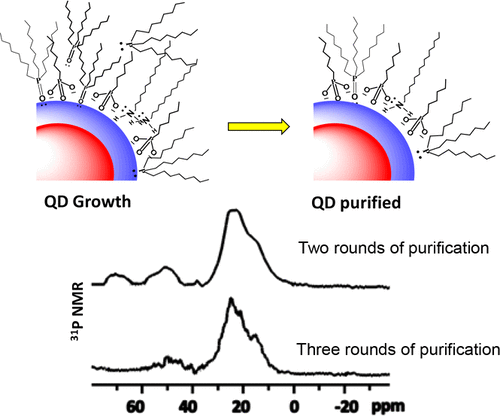当前位置:
X-MOL 学术
›
Chem. Mater.
›
论文详情
Our official English website, www.x-mol.net, welcomes your
feedback! (Note: you will need to create a separate account there.)
Characterization of the Ligand Capping of Hydrophobic CdSe–ZnS Quantum Dots Using NMR Spectroscopy
Chemistry of Materials ( IF 7.2 ) Pub Date : 2017-12-19 00:00:00 , DOI: 10.1021/acs.chemmater.7b04204 Birong Zeng 1, 2 , Goutam Palui 1 , Chengqi Zhang 1 , Naiqian Zhan 1 , Wentao Wang 1 , Xin Ji 1 , Banghao Chen 1 , Hedi Mattoussi 1
Chemistry of Materials ( IF 7.2 ) Pub Date : 2017-12-19 00:00:00 , DOI: 10.1021/acs.chemmater.7b04204 Birong Zeng 1, 2 , Goutam Palui 1 , Chengqi Zhang 1 , Naiqian Zhan 1 , Wentao Wang 1 , Xin Ji 1 , Banghao Chen 1 , Hedi Mattoussi 1
Affiliation

|
We have combined a few advanced solution phase NMR spectroscopy techniques, namely, 1H, 31P, heteronuclear single quantum coherence (HSQC), and diffusion ordered spectroscopy (DOSY), to probe the composition of the organic capping layer on colloidal CdSe–ZnS core–shell quantum dots grown via the “hot injection” route. Combining solution phase 31P and 1H NMR with DOSY, we are able to distinguish between free ligands and those coordinated on the QD surfaces. Furthermore, when those NMR measurements are complemented with matrix-assisted laser desorption ionization (MALDI) and FTIR data, we find that the organic shell of the as-prepared QDs consists of a mixture of tri-n-octylphosphine oxide (TOPO), tri-n-octylphosphine (TOP), alkyl amine, and alkyl phosphonic acid (L- and X-type ligands); the latter molecules are usually added during growth at a rather small concentration to improve the quality of the prepared nanocrystals. However, NMR data collected from QD dispersions subjected to two or three rounds of purification reveal that the organic shell composition (of purified QDs) is essentially dominated by monomeric or oligomeric n-hexylphosphonic acid, along with small fractions of surface-coordinated or hydrogen-bonded 1-hexadecyl amine and TOP/TOPO. This is true even though large excesses of TOP and TOPO surfactants are used during QD growth. This proves that n-hexylphosphonic acid (HPA) exhibits substantially higher coordinating affinity to the QD surfaces, compared to other phosphorus-containing surfactants such as TOP and TOPO. Finally, we test the utilitys of DOSY NMR to provide accurate data on the translational diffusion coefficient (and hydrodynamic radius) of QDs, as well as freely diffusing ligands in a sample. This proves that DOSY is a highly effective characterization technique for such small colloids and organic surfactants where DLS reaches its limit.
中文翻译:

核磁共振光谱法表征疏水性CdSe-ZnS量子点的配体封端
我们结合了一些先进的溶液相NMR光谱技术,即1 H,31 P,异核单量子相干(HSQC)和扩散有序光谱(DOSY),以探测胶体CdSe–ZnS上有机覆盖层的组成通过“热注入”途径生长的核-壳量子点。将溶液相31 P和1 H NMR与DOSY相结合,我们能够区分游离配体和QD表面配位的配体。此外,当这些NMR测量与基质辅助激光解吸电离(MALDI)和FTIR数据补充,我们发现,所制备的量子点的有机壳由三-的混合物的Ñ -octylphosphine氧化膦(TOPO),三--正辛基膦(TOP),烷基胺和烷基膦酸(L型和X型配体); 后者分子通常在生长过程中以相当低的浓度添加,以提高制备的纳米晶体的质量。但是,从经过两轮或三轮纯化的QD分散体中收集的NMR数据表明,(纯化QD的)有机壳组合物基本上由单体或低聚正己基膦酸以及少量的表面配位或氢原子所主导。键合的1-十六烷基胺和TOP / TOPO。即使在QD生长过程中使用了大量过量的TOP和TOPO表面活性剂,也是如此。这证明了n与其他含磷表面活性剂(例如TOP和TOPO)相比,-己基膦酸(HPA)对QD表面表现出更高的配位亲和力。最后,我们测试了DOSY NMR的效用,以提供有关QD的平移扩散系数(和流体动力学半径)以及样品中自由扩散配体的准确数据。这证明,对于DLS达到极限的此类小胶体和有机表面活性剂,DOSY是一种高效的表征技术。
更新日期:2017-12-19
中文翻译:

核磁共振光谱法表征疏水性CdSe-ZnS量子点的配体封端
我们结合了一些先进的溶液相NMR光谱技术,即1 H,31 P,异核单量子相干(HSQC)和扩散有序光谱(DOSY),以探测胶体CdSe–ZnS上有机覆盖层的组成通过“热注入”途径生长的核-壳量子点。将溶液相31 P和1 H NMR与DOSY相结合,我们能够区分游离配体和QD表面配位的配体。此外,当这些NMR测量与基质辅助激光解吸电离(MALDI)和FTIR数据补充,我们发现,所制备的量子点的有机壳由三-的混合物的Ñ -octylphosphine氧化膦(TOPO),三--正辛基膦(TOP),烷基胺和烷基膦酸(L型和X型配体); 后者分子通常在生长过程中以相当低的浓度添加,以提高制备的纳米晶体的质量。但是,从经过两轮或三轮纯化的QD分散体中收集的NMR数据表明,(纯化QD的)有机壳组合物基本上由单体或低聚正己基膦酸以及少量的表面配位或氢原子所主导。键合的1-十六烷基胺和TOP / TOPO。即使在QD生长过程中使用了大量过量的TOP和TOPO表面活性剂,也是如此。这证明了n与其他含磷表面活性剂(例如TOP和TOPO)相比,-己基膦酸(HPA)对QD表面表现出更高的配位亲和力。最后,我们测试了DOSY NMR的效用,以提供有关QD的平移扩散系数(和流体动力学半径)以及样品中自由扩散配体的准确数据。这证明,对于DLS达到极限的此类小胶体和有机表面活性剂,DOSY是一种高效的表征技术。











































 京公网安备 11010802027423号
京公网安备 11010802027423号